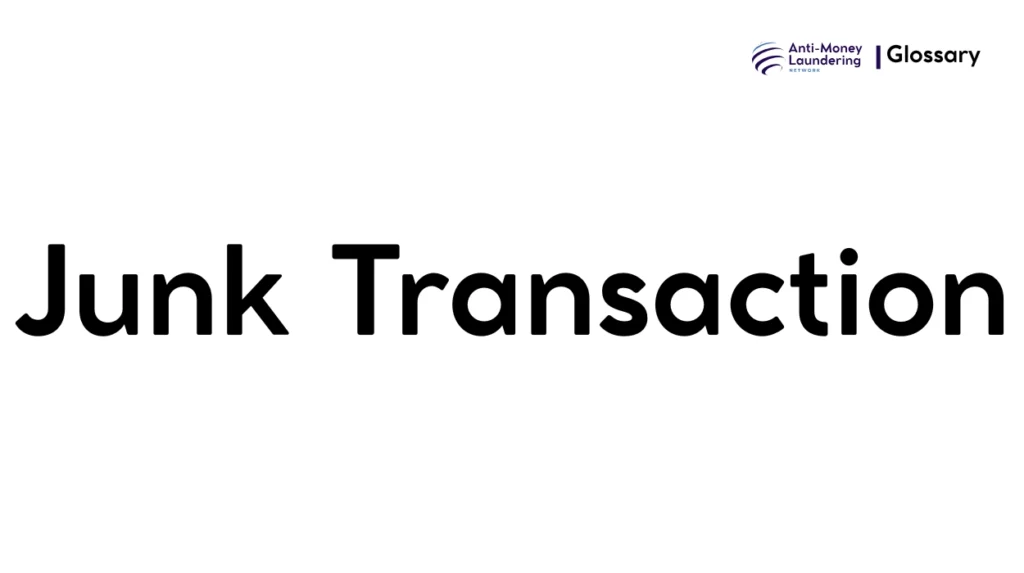Definition
In the context of Anti-Money Laundering (AML), a “Junk Transaction” refers to financial transactions that are characterized by excessive volume, frequency, or seemingly purposeless activity, often used as a smokescreen to obscure the true origin and destination of illicit funds. These transactions may appear as repetitive, low-value, or otherwise meaningless operations designed to overload monitoring systems, confuse audit trails, or disguise suspicious activities related to money laundering or terrorist financing. The term highlights transactions that serve no legitimate commercial or financial purpose and are detectable as red flags by AML compliance programs.
Purpose and Regulatory Basis
Junk transactions play a critical role within AML frameworks as they may be indicators or components of layering — a money laundering stage intended to distance illicit funds from their criminal sources by creating complex financial streams. Regulators and financial institutions focus on identifying and scrutinizing junk transactions to disrupt these obfuscation techniques.
Key global and national AML regulations address the monitoring and reporting of suspicious transaction patterns, including junk transactions:
- The Financial Action Task Force (FATF) Recommendations prescribe risk-based approaches to transaction monitoring, with emphasis on detecting unusual, repetitive, or purposeless transactions.
- The USA PATRIOT Act mandates financial institutions to implement robust suspicious activity reporting systems, including identifying transaction patterns inconsistent with customer profiles.
- The European Union’s Anti-Money Laundering Directives (AMLD) require enhanced due diligence in higher-risk scenarios, including the detection of nonsensical or repetitive transactions.
These regulatory regimes underscore the importance of identifying junk transactions as part of a comprehensive AML compliance program to prevent misuse of financial systems for illicit flows.
When and How it Applies
Junk transactions typically arise in real-world scenarios when money launderers attempt to layer illegal gains. Examples include:
- Multiple small-value transfers between accounts or entities not aligned with typical customer behavior.
- Repeated transactions that mirror artificial volume without economic rationale.
- Bulk payments or deposits processed with no logical commercial justification.
Triggers for scrutiny include transaction patterns that diverge sharply from expected norms, such as sudden spikes in activity or transfer volume inconsistent with customer history or business purpose.
Types or Variants
Junk transactions can manifest in various forms, including:
- High-frequency low-value transfers often referred to as “smurfing” or structuring.
- Rapid transfer chains across multiple accounts or jurisdictions to confuse tracing.
- Transactions involving unusual counterparties or shell companies with no clear business operations.
Each variant poses unique detection challenges and requires tailored monitoring strategies.
Procedures and Implementation
Financial institutions implement multiple layered controls to address junk transactions:
- Transaction Monitoring Systems (TMS) use algorithms and thresholds to flag atypical or voluminous transactions.
- Customer Risk Profiling to establish baseline behavior against which anomalies are identified.
- Enhanced Due Diligence (EDD) investigations triggered by alerts to evaluate the legitimacy of suspicious transactions.
- Periodic independent audits of AML systems to ensure effectiveness in capturing junk transaction activities.
- Training and awareness programs for staff to recognize patterns indicative of junk transactions and escalate appropriately.
Impact on Customers/Clients
From the client’s perspective, junk transaction scrutiny can lead to additional verification requests, temporary transaction holds, or enhanced monitoring of account activity. Legitimate customers may face inconvenience but retain rights to clear communication and appeal processes within institutions. Financial institutions must balance regulatory compliance with customer service quality and data privacy considerations.
Duration, Review, and Resolution
Junk transaction alerts require timely review, often within days of detection. Institutions maintain records of investigations, outcomes, and any associated suspicious activity reports (SARs). Resolution may involve transaction blocking, freezing of accounts, or filing SARs with relevant authorities. Institutions typically revisit customer profiles and transaction patterns regularly to detect reoccurrence or new risks.
Reporting and Compliance Duties
Institutions must document all detection and investigation steps related to junk transactions, maintain audit trails, and comply with mandatory reporting requirements under AML laws. Penalties for failure to act can include substantial fines and reputational damage. Regular reporting to financial intelligence units and supervisory authorities reinforces transparency and accountability.
Related AML Terms
Junk transactions intersect with other AML concepts such as:
- Money Laundering Stages (Placement, Layering, Integration)
- Structuring or Smurfing
- Suspicious Transaction Reporting (STR/SAR)
- Customer Due Diligence (CDD) and Enhanced Due Diligence (EDD)
- Transaction Laundering
Understanding junk transactions in this broader AML context is critical for effective risk management.
Challenges and Best Practices
Challenges in managing junk transactions include distinguishing between legitimate high-volume activity and illicit layering, minimizing false positives to reduce operational burden, and keeping pace with evolving laundering techniques. Best practices involve:
- Leveraging advanced analytics and AI to enhance pattern recognition.
- Continuous training for AML staff.
- Collaborative information sharing with regulators and other institutions.
- Implementing flexible, risk-based monitoring frameworks adaptable to diverse customer profiles.
Recent Developments
Recent AML technology advances utilize machine learning and big data to improve detection accuracy of junk transactions. Regulations increasingly emphasize real-time transaction monitoring and expanded data sources, including non-traditional financial channels. Enhanced cooperation between countries supports cross-border investigation of junk transaction schemes.
Junk transactions are a vital AML term referring to purposeless, repetitive financial activities used in money laundering layering to conceal illicit funds. Recognizing, monitoring, and managing such transactions is essential for financial institutions to comply with international AML regulations, protect the integrity of the financial system, and mitigate criminal exploitation risks.

